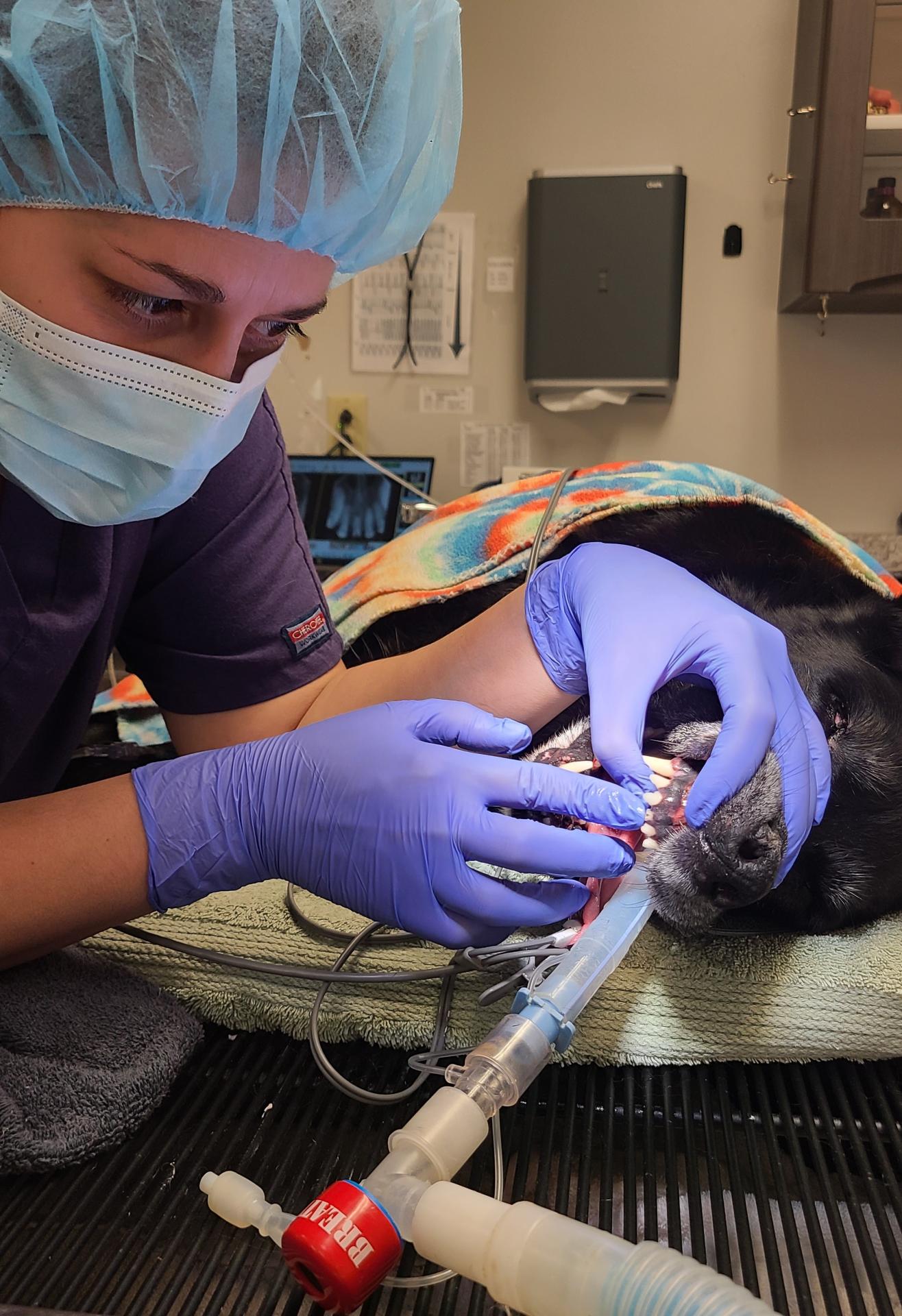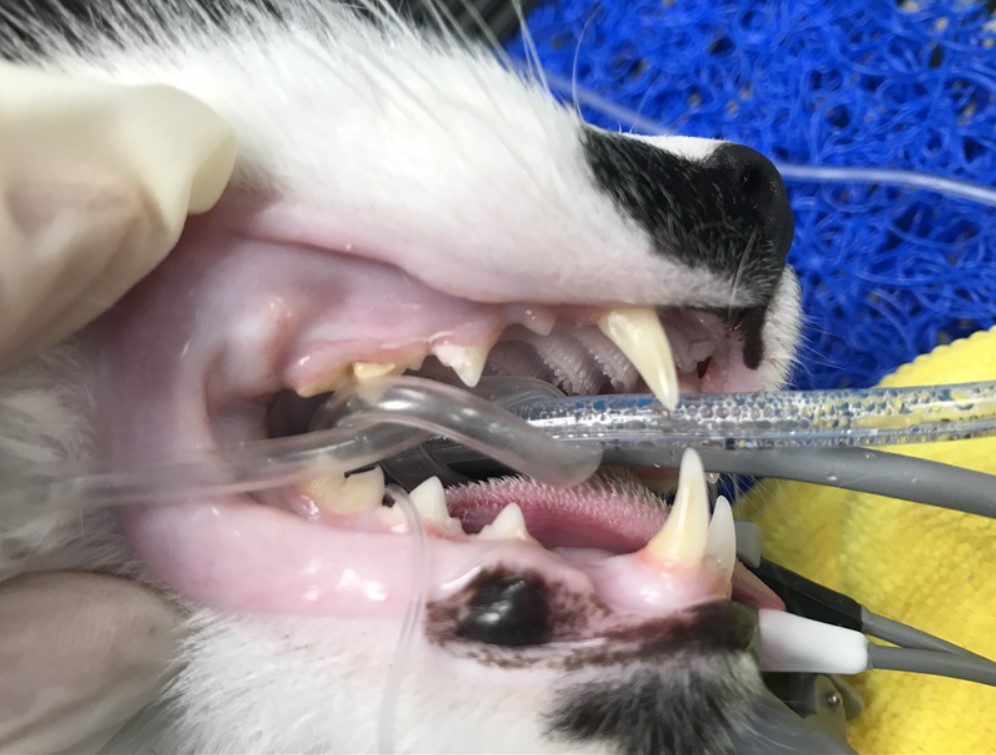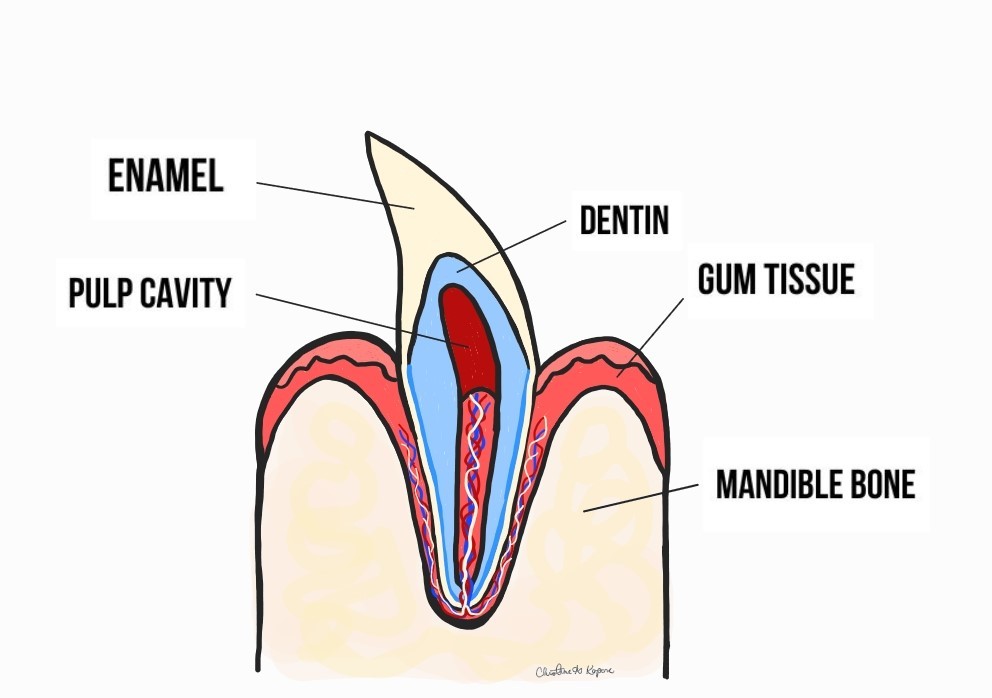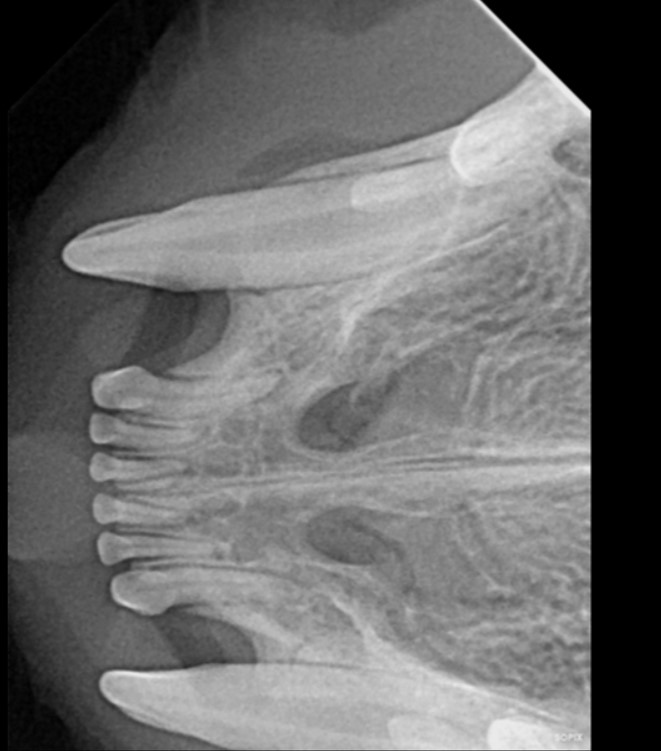 Your pet's yearly exam is here, and one focus will be on their teeth. A lift of their lips and surprise! Your pet has plaque and tartar formation, especially on those back molars. How embarrassing! Don't worry though, COHAT to the rescue. With this knowledge your veterinarian will recommend a professional teeth cleaning, otherwise known as a COHAT, a complete oral health assessment and treatment. What does that involve? A COHAT for your dog or cat includes many things depending on what is found during their full examination while under anesthesia. The goal of a COHAT is to clean, polish, and probe each tooth then take radiographs of each dental arcade so the veterinarian is able to look under the gumline and assess the root of every tooth. This information is used to determine if any teeth need treatment or removal to prevent and/or treat ongoing disease or infection. A dental chart is used to document each tooth and this important information is retained for future care of your pet.
Your pet's yearly exam is here, and one focus will be on their teeth. A lift of their lips and surprise! Your pet has plaque and tartar formation, especially on those back molars. How embarrassing! Don't worry though, COHAT to the rescue. With this knowledge your veterinarian will recommend a professional teeth cleaning, otherwise known as a COHAT, a complete oral health assessment and treatment. What does that involve? A COHAT for your dog or cat includes many things depending on what is found during their full examination while under anesthesia. The goal of a COHAT is to clean, polish, and probe each tooth then take radiographs of each dental arcade so the veterinarian is able to look under the gumline and assess the root of every tooth. This information is used to determine if any teeth need treatment or removal to prevent and/or treat ongoing disease or infection. A dental chart is used to document each tooth and this important information is retained for future care of your pet.
Who is involved in a COHAT procedure?
 The surgical team consists of a Licensed Veterinarian (DVM) as well as a Registered Veterinary Technician (RVT). The start of the COHAT will entail the RVT cleaning and polishing your pet's teeth. Radiographs are then taken of each dental arcade. During this time, the veterinarian is overseeing your pet's vitals and making sure they are doing well under anesthesia. The veterinarian is present the entire procedure from start to finish. Next, the veterinarian will probe each tooth, analyze the dental radiographs, and perform needed oral surgeries and treatments. These may include extractions, mass removals, and gingival flap surgery to correctly remove multi-rooted teeth. During these procedures, the RVT monitors your pet's vitals including respirations, blood pressure, ECG, temperature, among others. While under anesthesia, your pet is given appropriate medications to control any nausea and pain as well as IV fluids to stay hydrated. When the COHAT is complete, your pet will go into recovery for continued monitoring until awake. Once ready, arrangements for pickup and review of the COHAT including at home care will be made and communicated with you.
The surgical team consists of a Licensed Veterinarian (DVM) as well as a Registered Veterinary Technician (RVT). The start of the COHAT will entail the RVT cleaning and polishing your pet's teeth. Radiographs are then taken of each dental arcade. During this time, the veterinarian is overseeing your pet's vitals and making sure they are doing well under anesthesia. The veterinarian is present the entire procedure from start to finish. Next, the veterinarian will probe each tooth, analyze the dental radiographs, and perform needed oral surgeries and treatments. These may include extractions, mass removals, and gingival flap surgery to correctly remove multi-rooted teeth. During these procedures, the RVT monitors your pet's vitals including respirations, blood pressure, ECG, temperature, among others. While under anesthesia, your pet is given appropriate medications to control any nausea and pain as well as IV fluids to stay hydrated. When the COHAT is complete, your pet will go into recovery for continued monitoring until awake. Once ready, arrangements for pickup and review of the COHAT including at home care will be made and communicated with you.
Specifics regarding dog dental disease:
Every pet has different predispositions to a multitude of health problems including their oral health. A study conducted by the Royal Veterinary College of London in 2021 explored dental disease in dogs specifically. They used the medical records of over 22,333 dogs and found some interesting trends:
- An increase in age is strongly associated with increased risk of dental disease with dogs over 12 having almost 4 times the risk compared to dogs who were between 2 and 4 years old
- A dog who weighs less than 22 pounds has over 3 times the risk of dental disease compared to dogs who weighed 66-88 pounds
- The thought behind this: All dogs have the same number of teeth (42) and the teeth in a large dog's mouth are much more spaced out compared to a small dog less than 22 pounds
- Breeds that had the highest risk and severity of dental disease included Greyhound, Toy Poodle, King Charles Spaniel, and Cavalier King Charles Spaniel
- Breeds that showed reduced risk and severity of dental disease were German Shepherd, Labrador Retriever, French Bulldog, and Staffordshire Bull Terrier
Cats and dental disease:
 Our feline companions suffer from dental disease more than we realize. According to the Cornell Feline Health Center at Cornell University College of Veterinary Medicine 50-60% of cats over the age of four suffer from dental disease. Sadly this can be prevented and must be managed when it occurs. A common presentation of a cat who has severe dental disease is decreased or absent appetite often accompanied with severe pain, discomfort, and drooling. There may also be a preference for softer foods. Cats who suffer from autoimmune diseases including Feline Leukemia and Feline Immunodeficiency virus, kidney disease, and diabetes are predisposed to gingivitis. Gingivitis is the inflammation, pain, and in severe cases bleeding of the gums. The most effective way to help prevent gingivitis in your cat's mouth is regular teeth brushing at home and professional teeth cleanings by your licensed veterinarian. The cleaning removes plaque and tartar build-up to reduce inflammation and periodontal disease. Another common oral disease process in cats is resorptive lesions occurring in 30-70% of our feline patients. Tooth resorption is a process where the dentin of the tooth starts to break down.
Our feline companions suffer from dental disease more than we realize. According to the Cornell Feline Health Center at Cornell University College of Veterinary Medicine 50-60% of cats over the age of four suffer from dental disease. Sadly this can be prevented and must be managed when it occurs. A common presentation of a cat who has severe dental disease is decreased or absent appetite often accompanied with severe pain, discomfort, and drooling. There may also be a preference for softer foods. Cats who suffer from autoimmune diseases including Feline Leukemia and Feline Immunodeficiency virus, kidney disease, and diabetes are predisposed to gingivitis. Gingivitis is the inflammation, pain, and in severe cases bleeding of the gums. The most effective way to help prevent gingivitis in your cat's mouth is regular teeth brushing at home and professional teeth cleanings by your licensed veterinarian. The cleaning removes plaque and tartar build-up to reduce inflammation and periodontal disease. Another common oral disease process in cats is resorptive lesions occurring in 30-70% of our feline patients. Tooth resorption is a process where the dentin of the tooth starts to break down.
 As seen in the drawing above of a feline tooth, dentin is next to the pulp cavity. The pulp cavity contains the nerve and blood supply to the tooth. A lesion in this area results in severe pain for your cat and full evaluation for this disease process can only be completed under anesthesia. Dental radiographs along with probing are key to diagnosis. Teeth with resorptive lesions require extractions to stop the excruciating pain they cause.
As seen in the drawing above of a feline tooth, dentin is next to the pulp cavity. The pulp cavity contains the nerve and blood supply to the tooth. A lesion in this area results in severe pain for your cat and full evaluation for this disease process can only be completed under anesthesia. Dental radiographs along with probing are key to diagnosis. Teeth with resorptive lesions require extractions to stop the excruciating pain they cause.
Do I really need to get my pet's teeth cleaned and what can happen if I don't?
 The dental health of your pet goes beyond them having "stinky breath". Just like us, your pet's mouth is full of bacteria. When not in check with regular at home tooth brushing and professional teeth cleanings, plaque and tartar accumulation will result in gum recession. Did you know that plaque forms on the teeth just hours after brushing? Tartar also provides a location for more bacteria to grow in the mouth. Unfortunately, excess bacteria involved in dental disease not only has the possibility to cause local infection and create abscesses in your dog or cat's mouth, but can lead to systemic problems as well. Severe dental disease will expose your dog or cat's kidney, liver, and heart to harmful bacteria. According to Virginia-Maryland College of Veterinary Medicine, dental disease has been connected with an increase in heart related disease including valvular disease and endocarditis.
The dental health of your pet goes beyond them having "stinky breath". Just like us, your pet's mouth is full of bacteria. When not in check with regular at home tooth brushing and professional teeth cleanings, plaque and tartar accumulation will result in gum recession. Did you know that plaque forms on the teeth just hours after brushing? Tartar also provides a location for more bacteria to grow in the mouth. Unfortunately, excess bacteria involved in dental disease not only has the possibility to cause local infection and create abscesses in your dog or cat's mouth, but can lead to systemic problems as well. Severe dental disease will expose your dog or cat's kidney, liver, and heart to harmful bacteria. According to Virginia-Maryland College of Veterinary Medicine, dental disease has been connected with an increase in heart related disease including valvular disease and endocarditis.
If you are concerned about your dog or cat's oral health, please call and schedule an initial examination. Our doctors can provide a treatment plan for a professional teeth cleaning and potential treatments tailored to your pet. Please share any concerns so we can address them in person. We aim to provide the best care possible and are happy to answer any questions you may have regarding a COHAT procedure.

